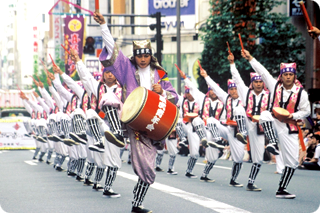What is Eisa?日本語→
Eisa is a traditional folk dance in Ryukyu Islands, performed mainly during the Obon Festival, from 13th to 15th of July. July 13th is unke (welcome day), when ancestor spirits come back to the living world to visit their families. They stay during 14th or nakanuhí (middle day) and leave on ukui (seeing off day), July 15th. On this last day, young people of each village get together and parade the streets, dancing and beating taiko drums with the rhythm of folk music. Each village has its own songs and dances.
How did eisa start?
Actually, the origin of eisa is not clear and there are several different stories. The most widely believed story is the following:
During the Shonei Dynasty Period (1587–1620), a holy priest called Taichu Jojin stayed in Okinawa on his way from Kyoto to China. As a part of his mission, he introduced Buddhist prayers and chants to Okinawa, translated into a poetry form (combination of five words and seven words), this is believed to be the beginning of Amida Buddha in Okinawa. As a part of the efforts to propagate Buddhism, Taichu Jojin introduced Amida Buddha dances so that people could remember difficult Amida Buddha. These dances were called 沖順流りand Keibo Nenbutsu and considered as the origin of eisa. In order to propagate these teachings, dances from the Jodo Buddhist sect were added to the chants and songs to make them easier to remember. This marked the origin of the eisa we see today.
As the time went by, this Buddhist dance became a part of the tradition, mixed with Okinawa’s culture and changed its meaning to “seeing off ancestors’ spirits.” These changes from the origin are strongly reflected in the traditional eisa uniform (black clothes and bare foot) as well as the custom to visit households as they parade the streets.
The word of eisa came from a musical accompaniment “eisa, eisa” of Amida Buddha songs, and it is considered to come from Esaomoro, which is the 14th song of Omorosaushi.
Omorosaushi is a book composed of songs in Okinawa and Amami Islands from 12th to 17th century and called Manyoshu (famous book of Japanese old poet) of Okinawa. “Esa” of “Esaomoro” means a phrase that harmonizes to group dancing and is considered as the preliminary form of the group eisa dance songs. Unfortunately, this tradition is not directly related to eisa songs today whose origins have various backgrounds such as Buddhism songs and traditional Okinawa songs.
Eisa has this history but keeps on changing. Especially, in All Okinawa Eisa Contest (now is called All Okinawa Eisa Festival), started in 1956, youth associations from all over Okinawa have been making tremendous efforts to win, which resulted in luxurious uniforms and unique choreography. Today, we can enjoy eisa other time than Obon period and outside of Okinawa.

Itoman City Cann young person association
from the 1st Shinjuku Eisa festival
With the passage of time many changes occurred, and eisa we see today have developed a stronger sense of the performing arts, being much more enjoyable to watch. Primarily owing to the “Zento Eisa Contest” that started in 1956 young groups from various places competed against each other, and, in order to try to win the contest, each has proactively introduced elements from other arts, displaying remarkable improvements in drum and dancing techniques, and costume attractiveness.
Today, eisa is not limited to Okinawa or the Obon Festival, and it can be enjoyed in many diverse festivals throughout Japan and the World.
What is Ryukyu Budan Shoryu Matsuri Daiko? | Organization, Philosophy, and Objective












